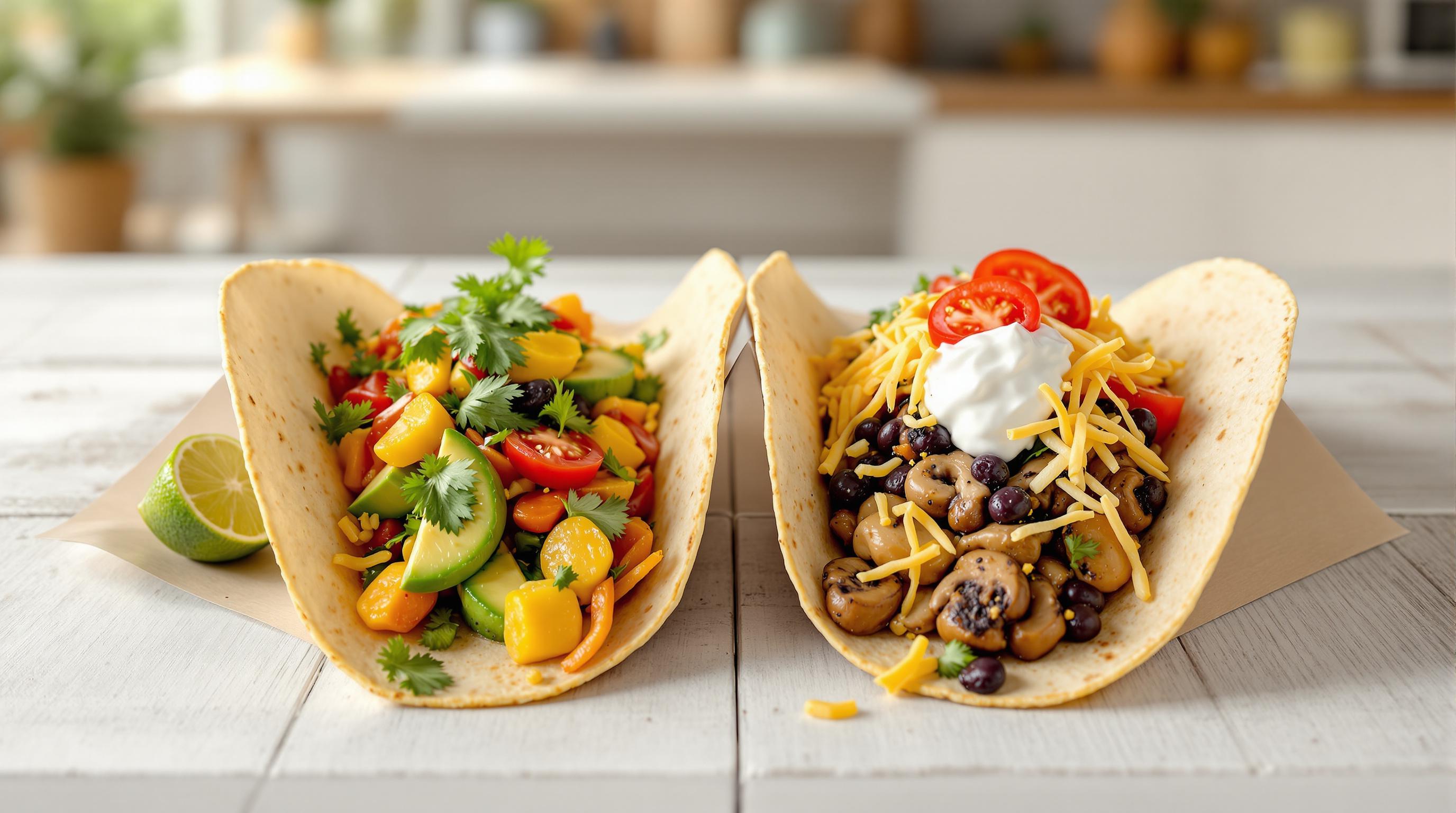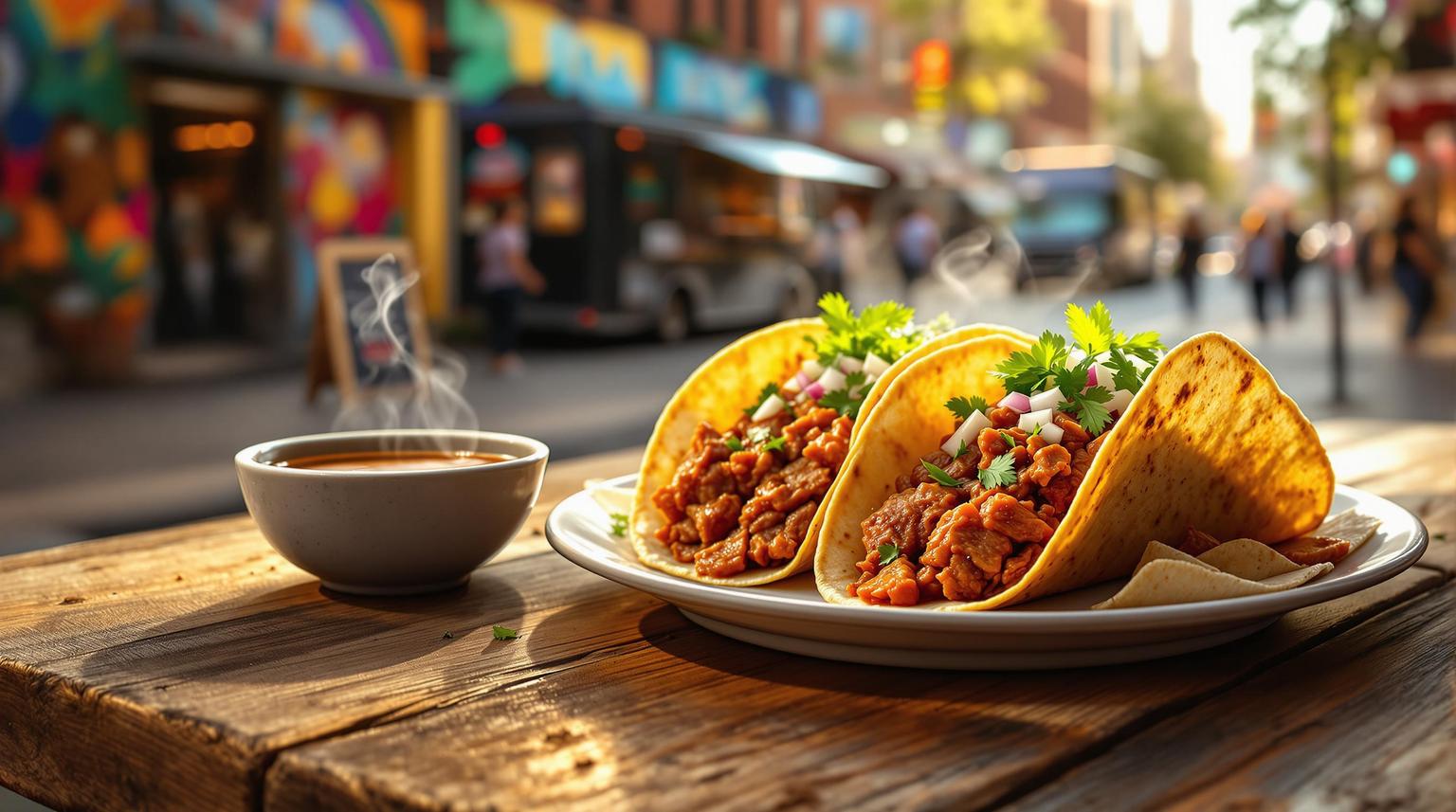Salsa verde and avocado salsa are both green salsas rooted in Mexican cuisine, but they differ in ingredients, texture, and flavor. Here's a quick breakdown:
- Salsa Verde: Made with tomatillos, chiles, cilantro, onion, and garlic. It’s tangy, thin, and zesty - perfect for drizzling over tacos, grilled meats, or enchiladas.
- Avocado Salsa: Combines tomatillos with ripe avocado, resulting in a creamy, mild, and smooth salsa. It’s great for cooling spicy dishes or as a dip.
Quick Comparison
| Feature | Salsa Verde | Avocado Salsa |
|---|---|---|
| Base Ingredient | Tomatillos | Tomatillos + Avocado |
| Texture | Thin and pourable | Creamy and thick |
| Flavor | Tangy and bold | Mild and smooth |
| Best Uses | Tacos, grilled meats, soups | Spicy dishes, dips, tacos |
Choose salsa verde for a bright, zesty kick or avocado salsa for a creamy, cooling balance. Both salsas elevate Mexican-inspired meals in their own way.
Rick Bayless Essential Salsas: Avocado-Tomatillo Salsa
Main Ingredients: How They Differ
Both salsas start with the same foundation - tomatillos - but the inclusion of avocado in one recipe takes the texture and flavor in a whole new direction. Let’s break down how their core ingredients set them apart.
Salsa Verde: Tomatillo Base
Salsa verde is built around tomatillos, those small, tangy green fruits that pack a signature tartness [5]. This vibrant base is combined with serrano or jalapeño chiles, fresh cilantro, white onion, and garlic to create its bold, zesty profile. A common preparation method involves roasting these ingredients, which adds a smoky, charred depth to the salsa’s flavor [4]. The result? A bright, punchy condiment that’s a staple in Mexican cuisine.
Avocado Salsa: Tomatillos Plus Avocado
Avocado salsa starts with the same tomatillo foundation but introduces ripe avocado into the mix [3], striking a balance between guacamole and salsa [3]. The avocado not only softens the tomatillos' sharp tang but also gives the salsa a creamy, velvety texture [1]. As chef Rick Bayless points out:
The avocado helps solve the textural problem, but this salsa is still best eaten within a few hours of making it. [1]
While the ingredient list - tomatillos, chiles, cilantro, onion, and garlic - remains largely the same, adding 1–2 ripe avocados transforms the salsa into a rich, dairy-free condiment. This creaminess makes it an ideal pairing for spicy dishes, offering a smooth, cooling contrast. Unlike the bright acidity of salsa verde, avocado salsa delivers a lush, creamy coating that enhances the overall flavor of your meal.
Texture Differences: Thin vs Creamy
The texture is what truly distinguishes these two salsas. Adding avocado to the mix changes everything, creating two distinct consistencies that lend themselves to different uses and flavor profiles.
Salsa Verde: Thin and Smooth
Salsa verde gets its light, smooth texture from blending roasted or boiled tomatillos, chiles, garlic, onion, and cilantro with water. This process creates a sauce that’s thin enough to pour easily off a spoon [7][9]. Its fluid consistency makes it perfect for drizzling over tacos, enchiladas, or grilled meats. It’s also a great choice as a marinade, thanks to its ability to seep into proteins effortlessly [6].
Cookbook author Lisa Bryan from Downshiftology highlights the difference between salsa verde and green enchilada sauce:
Green enchilada sauce is meant to be a bit thicker and made with broth. So, I'd say it's not an exact replacement since salsa verde is very light in texture. [7]
Chef Rick Bayless also praises its versatility:
In the tradition of Mexican salsas, its easy spoonability and bright flavor make it a perfect condiment. [1]
Avocado Salsa: Thick and Rich
On the other hand, avocado salsa offers a creamier, thicker texture. It’s not as dense as guacamole but still provides a satisfying richness [6]. The addition of ripe avocado gives it a velvety smoothness while maintaining enough body to coat food generously. By blending diced avocado - ripe but firm - you get a sauce that’s both creamy and balanced in texture [8].
Chef Rick Bayless describes this unique texture:
It's smoother and saucier than what any of us would think of as the ubiquitous chip dip, and it's zestier. [1]
The creamy texture of avocado salsa not only cools down spicy dishes but also adds a subtle tang that complements heat beautifully [6]. Unlike the sharper, lighter bite of salsa verde, its richness provides a soothing, balanced finish, making it an excellent choice for dishes with a lot of spice.
sbb-itb-8621021
Flavor Comparison: Tangy vs. Mild
Salsa verde and avocado salsa might share a few ingredients, but they deliver entirely different flavor profiles. While salsa verde is known for its bold tanginess, avocado salsa brings a creamy, mild taste that mellows out spicy dishes.
Salsa Verde: Bright and Tangy
Salsa verde is all about its sharp, zesty kick. As Carlsbad Cravings puts it:
dynamic punch of bright tanginess [11]
This distinct flavor comes from tomatillos, which are naturally tart and citrusy - something regular tomatoes just can't replicate. You can tweak its tanginess by adding lime juice, a splash of vinegar, or even a pinch of sugar. Using raw tomatillos gives it a vibrant, sour edge, while cooking them introduces a deeper, smoky flavor.
If salsa verde is all about boldness, avocado salsa takes a softer approach.
Avocado Salsa: Creamy and Mild
Avocado salsa blends ripe avocados with tomatillos to create a smoother, less tangy option. The creamy avocado balances the acidity of tomatillos, resulting in a silky texture and a mild flavor. It’s often described as "guacamole's sophisticated cousin" [10], thanks to how effortlessly it combines with peppers, onions, and cilantro. This rich, buttery profile makes it perfect for taming the heat of spicier dishes, offering the brightness of salsa verde but with a gentler touch that complements more delicate flavors.
When to Use Each Salsa
Picking between salsa verde and avocado salsa can transform your meal, as each brings its own distinct flair. By understanding their unique flavors and textures, you can pair them perfectly with the right dishes.
Salsa Verde: Bright and Tangy
Salsa verde's tangy, acidic kick is perfect for cutting through rich dishes and adding a pop of brightness. It’s a go-to for enhancing the flavors of heavier foods and elevating simple recipes.
- Tacos, burritos, and tostadas: A drizzle of salsa verde takes these classics to the next level, adding a zesty touch. It's also a key ingredient in traditional enchiladas.
- Breakfast dishes: Pour it over eggs or hash for a quick and flavorful morning boost[2].
- Grilled meats: Its acidity complements smoky, charred flavors, making it a refreshing addition to steaks, chicken, or pork[12].
- Vegetables and soups: Toss roasted veggies in salsa verde for a flavor upgrade or stir it into soups and stews for added depth.
Avocado Salsa: Cool and Creamy
When you need to mellow out spicy dishes or add a creamy richness, avocado salsa is your best choice. Its smooth, buttery texture and mild flavor bring balance to bold, fiery meals while keeping the brightness of tomatillos.
- Tacos and burritos: Avocado salsa’s cooling creaminess makes it a fantastic topping for these dishes, as highlighted by Mexican Please[15].
- Grilled proteins: Whether it's chicken breast or pan-seared salmon, this salsa enhances delicate flavors without overpowering them[13][14].
- Drizzling or dipping: Unlike chunky guacamole, avocado salsa’s thinner consistency makes it versatile. Use it as a marinade, drizzle it over dishes, or serve it as a dip with tortilla chips for a creamy yet light option.
If you love the tang of salsa verde but crave a smoother, more luxurious texture, avocado salsa is the way to go. Each salsa has its moment to shine - choose based on the flavors and textures your dish needs.
Which Salsa Should You Choose
The choice between salsa verde and avocado salsa depends on the flavor and texture your dish calls for.
Salsa verde is your go-to when you want to add a zesty brightness to hearty dishes. With its tangy tomatillo base, it cuts through the richness of fatty meats like chorizo, carnitas, or al pastor, making it a classic pairing for traditional tacos. On the other hand, avocado salsa offers a creamy, smooth texture that brings a cooling element to spicy dishes. Its velvety consistency works beautifully on fiery tacos and burritos, and it’s especially great for drizzling over your favorite fillings.
Each salsa has its strengths. Salsa verde is robust enough to be prepared in advance, retaining its flavor and texture over time. Meanwhile, avocado salsa is best enjoyed fresh, as its vibrant green hue can quickly fade if left too long.
Take Chicago’s taco scene as an example. At Tatas Tacos in Lakeview, fried potato taquitos are topped with salsa verde, crema, and cheese for a perfectly balanced bite [16]. This showcases how salsa verde shines in complementing rich, fried flavors.
Having both salsas on hand is a smart move for any taco lover. Whether you’re looking to brighten a savory pork taco or cool the heat of a spicy birria, these versatile salsas ensure you’re ready for any taco adventure. For more taco inspiration, visit Chicago Taco Spot.
FAQs
What’s the difference between salsa verde and avocado salsa, and how do I choose the right one?
The main distinction between salsa verde and avocado salsa comes down to their ingredients, texture, and flavor profiles. Salsa verde is crafted with tomatillos, giving it a tangy, slightly tart flavor and a smooth, pureed consistency. It’s a fantastic choice for adding a zesty punch to dishes like tacos, enchiladas, or grilled meats - especially chicken or pork.
Avocado salsa, in contrast, blends tomatillos with creamy avocados, creating a rich and velvety texture. Its flavor is milder and works wonderfully as a dip for chips or as a topping for grilled dishes, making it a favorite at summer cookouts. If you’re craving bold, tangy flavors, go for salsa verde. For a creamier, more refreshing option, avocado salsa is the way to go!
How can I store salsa verde and avocado salsa to keep them fresh?
To keep salsa verde at its best, store it in an airtight container in the fridge, where it will stay fresh for up to 5–7 days. If you’d like to keep it longer, freezing is a great option - it can last up to 3 months in the freezer.
For avocado salsa, refrigeration is key. Store it in an airtight container and use it within 3 days. To keep it from browning, press plastic wrap directly onto the salsa's surface. A splash of lime juice not only enhances the flavor but also helps preserve its vibrant color.
While both salsas are tastiest when freshly made, these storage tips can help you enjoy their flavors and textures a little longer!
Can you use avocado salsa instead of guacamole, and how do their flavors and textures differ?
Yes, you can absolutely swap out guacamole for avocado salsa in many dishes. While they share core ingredients like avocados, lime, and cilantro, the two have distinct textures and flavors. Avocado salsa tends to be smoother and lighter, often with a tangy twist from ingredients like tomatillos or jalapeños. On the other hand, guacamole is thicker, chunkier, and delivers a creamier, richer taste.
Another advantage of avocado salsa is its ability to stay fresh longer without browning, making it a handy option for dips, taco toppings, or as a flavorful side. If you're craving something zesty and refreshing, avocado salsa is a fantastic alternative to guacamole!


